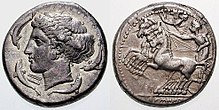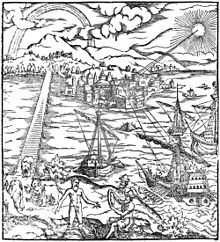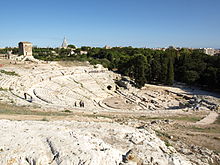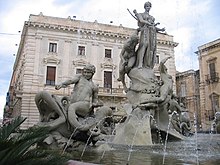Syracuse, Sicily
You can help expand this article with text translated from the corresponding article in Italian. (January 2022) Click [show] for important translation instructions.
|
Syracuse
| |
|---|---|
| Comune di Siracusa | |
From top left: Ortygia island, where Syracuse was founded in ancient Greek times, Greek Theatre, Palazzo Dell'Orologio, Monument to Archimedes in Piazza Archimedes, Cathedral of Syracuse, Ortygia Bridges, Fountain of Diana | |
UTC+2 (CEST) | |
| Postal code | 96100 |
| Dialing code | 0931 |
| Patron saint | Saint Lucy |
| Saint day | 13 December |
| Website | comune.siracusa.it |
Syracuse (
The city was founded by
In the modern day, the city is listed by UNESCO as a World Heritage Site along with the Necropolis of Pantalica. In the central area, the city itself has a population of around 125,000 people. Syracuse is mentioned in the Bible in the Acts of the Apostles book at 28:12 as Paul stayed there.[12] The patron saint of the city is Saint Lucy; she was born in Syracuse and her feast day, Saint Lucy's Day, is celebrated on 13 December.
History
Archaic period




Syracuse and its surrounding area have been inhabited since ancient times, as shown by the findings in the villages of Stentinello, Ognina, Plemmirio, Matrensa, Cozzo Pantano and Thapsos, which already had a relationship with Mycenaean Greece.
Syracuse was founded in 734 or 733 BC in Sicily by Greek settlers from
(598 BC).Classical period

The descendants of the first colonists, called Gamoroi, held power until they were expelled by the lower class of the city assisted by Cyllyrians, identified as enslaved natives similar in status to the
Syracuse grew considerably during this time. Its walls encircled 120 hectares (300 acres) in the fifth century, but as early as the 470s BC the inhabitants started building outside the walls. The complete population of its territory approximately numbered 250,000 in 415 BC and the population size of the city itself was probably similar to Athens.[11]
Gelo was succeeded by his brother
Then in the early 4th century BC, the
His successor was
Hellenistic period

After Timoleon's death the struggle among the city's parties restarted and ended with the rise of another tyrant, Agathocles, who seized power with a coup in 317 BC. He resumed the war against Carthage, with alternate fortunes. He was besieged in Syracuse by the Carthaginians in 311 BC, but he escaped from the city with a small fleet. He scored a moral success, bringing the war to the Carthaginians' native African soil, inflicting heavy losses to the enemy. The defenders of Syracuse destroyed the Carthaginian army which besieged them. However, Agathocles was eventually defeated in Africa as well. The war ended with another treaty of peace which did not prevent the Carthaginians from interfering in the politics of Syracuse after the death of Agathocles (289 BC). They laid siege to Syracuse for the fourth and last time in 278 BC. They retreated at the arrival of king Pyrrhus of Epirus, whom Syracuse had asked for help. After a brief period under the rule of Epirus, Hiero II seized power in 275 BC.
Hiero inaugurated a period of 50 years of peace and prosperity, in which Syracuse became one of the most renowned capitals of Antiquity. He issued the so-called
Hiero's successor, the young
Imperial Roman and Byzantine period




Though declining slowly through the years, Syracuse maintained the status of capital of the Roman government of Sicily and seat of the
After a period of
Emirate of Sicily
The city was
Norman kingdom of Sicily
In 1038, the Byzantine general
High medieval period
In 1194,
16th–20th centuries
The city was struck by two ruinous earthquakes in 1542 and 1693, and a plague in 1729. The 17th century destruction changed the appearance of Syracuse forever, as well as the entire Val di Noto, whose cities were rebuilt along the typical lines of Sicilian Baroque, considered one of the most typical expressions of the architecture of Southern Italy. The spread of cholera in 1837 led to a revolt against the Bourbon government. The punishment was the move of the province capital seat to Noto, but the unrest had not been totally choked, as the Siracusani took part in the Sicilian revolution of 1848.
After the Unification of Italy of 1865, Syracuse regained its status of provincial capital. In the late 19th century, the walls (including Porta Ligny) were demolished and a bridge connecting the mainland to Ortygia island was built. In the following year a railway link was constructed.
Modern history
Syracuse today has about 125,000 inhabitants and numerous attractions for the visitor interested in historical sites (such as the
Geography
Climate
Syracuse experiences a hot-summer Mediterranean climate (Köppen climate classification: Csa) with mild, wet winters and hot, dry summers. Snow is infrequent; the last measurable snowfall in the city occurred in December 2014.[25] Frosts are very rare, with the last one also happening in December 2014 when the temperature dropped to the all-time record low of 0 °C.
A temperature of 48.8 °C (119.8 °F) was registered in Floridia, near Syracuse by the Sicilian Agrometeorological Information Service (SAIS) on 11 August 2021, and is recognized by the World Meteorological Organization as the official record highest temperature in Europe.[26] Guido Guidi, lieutenant colonel of the Italian Meteorological Service, however, had stated the highest temperature registered in the organizations' stations during the heatwave was 44.4 °C (111.9 °F), at Naval Air Station Sigonella.[27] Guidi underlines that the reported data by SAIS "is produced directly by the stations and is not subject to any control and validation procedure, neither automatic nor manual. It can therefore report errors due to sensor malfunctions as well as maintenance interventions".[27]
| Climate data for Syracuse (unknown period) | |||||||||||||
|---|---|---|---|---|---|---|---|---|---|---|---|---|---|
| Month | Jan | Feb | Mar | Apr | May | Jun | Jul | Aug | Sep | Oct | Nov | Dec | Year |
| Record high °C (°F) | 25.0 (77.0) |
26.4 (79.5) |
29.6 (85.3) |
32.9 (91.2) |
36.0 (96.8) |
38.4 (101.1) |
44.8 (112.6) |
41.0 (105.8) |
37.8 (100.0) |
32.1 (89.8) |
27.2 (81.0) |
25.0 (77.0) |
44.8 (112.6) |
| Mean daily maximum °C (°F) | 14.8 (58.6) |
15.3 (59.5) |
17.1 (62.8) |
19.7 (67.5) |
23.7 (74.7) |
28.2 (82.8) |
31.3 (88.3) |
31.2 (88.2) |
28.1 (82.6) |
24.0 (75.2) |
19.6 (67.3) |
16.3 (61.3) |
22.4 (72.3) |
| Daily mean °C (°F) | 11.1 (52.0) |
11.4 (52.5) |
12.9 (55.2) |
15.2 (59.4) |
18.8 (65.8) |
23.0 (73.4) |
26.0 (78.8) |
26.2 (79.2) |
23.7 (74.7) |
20.0 (68.0) |
15.8 (60.4) |
12.6 (54.7) |
18.1 (64.6) |
| Mean daily minimum °C (°F) | 7.3 (45.1) |
7.5 (45.5) |
8.7 (47.7) |
10.7 (51.3) |
13.9 (57.0) |
17.8 (64.0) |
20.7 (69.3) |
21.2 (70.2) |
19.2 (66.6) |
16.0 (60.8) |
12.1 (53.8) |
9.0 (48.2) |
13.7 (56.7) |
| Record low °C (°F) | −0.5 (31.1) |
−1.2 (29.8) |
−0.4 (31.3) |
2.4 (36.3) |
7.6 (45.7) |
11.0 (51.8) |
13.5 (56.3) |
14.6 (58.3) |
13.4 (56.1) |
8.6 (47.5) |
2.4 (36.3) |
1.2 (34.2) |
−1.2 (29.8) |
| Average precipitation mm (inches) | 75 (3.0) |
52 (2.0) |
44 (1.7) |
30 (1.2) |
16 (0.6) |
5 (0.2) |
3 (0.1) |
7 (0.3) |
44 (1.7) |
78 (3.1) |
94 (3.7) |
78 (3.1) |
526 (20.7) |
| Average precipitation days | 9 | 7 | 6 | 4 | 3 | 1 | 1 | 1 | 4 | 7 | 8 | 9 | 60 |
| Average ultraviolet index | 2 | 3 | 5 | 7 | 8 | 9 | 10 | 9 | 7 | 5 | 3 | 2 | 6 |
| Source: Archivio climatico Enea-Casaccia[28] and Weather Atlas[29][30] Extremes(1946-present)[31] | |||||||||||||
Government
Demographics
In 2016, there were 122,051[1] people residing in Syracuse, located in the province of Syracuse, Sicily, of whom 48.7% were male and 51.3% were female. Minors (children ages 18 and younger) totalled 18.9 percent of the population compared to pensioners who number 16.9 percent. This compares with the Italian average of 18.1 percent (minors) and 19.9 percent (pensioners). The average age of Syracuse resident is 40 compared to the Italian average of 42. In the five years between 2002 and 2007, the population of Syracuse declined by 0.5 percent, while Italy as a whole grew by 3.6 percent. The reason for decline is a population flight to the suburbs, and northern Italy.[32][33] The current birth rate of Syracuse is 9.75 births per 1,000 inhabitants compared to the Italian average of 9.45 births.
As of 2006[update], 97.9% of the population was of Italian descent. The largest immigrant group came from other European nations (particularly those from Poland, and the United Kingdom): 0.6%, North Africa (mostly Tunisian): 0.5%, and South Asia: 0.4%.
Tourism
| UNESCO World Heritage Site | |
|---|---|
 The Greek theatre of Syracuse | |
| Criteria | Cultural: ii, iii, iv, vi |
| Reference | 1200 |
| Inscription | 2005 (29th Session) |
| Area | 898.46 ha |
| Buffer zone | 5,519.4 ha |
Since 2005, the entire city of Syracuse, along with the
Buildings of the Greek and Roman periods
- The city walls
- The Temple of Apollo, at Piazza Emanuele Pancali, adapted to a church in Byzantine times and to a mosque under Arab rule.
- The
- The Greek Theatre, whose cavea is one of the largest ever built by the ancient Greeks: it has 67 rows, divided into nine sections with eight aisles. Only traces of the scene and the orchestra remain. The edifice (still used today) was modified by the Romans, who adapted it to their different style of spectacles, including also circus games. Near the theatre are the latomìe, stone quarries, also used as prisons in ancient times. The most famous latomìa is the Orecchio di Dionisio ("Ear of Dionysius").
- The Roman amphitheatre. It was partly carved out from the rock. In the centre of the area is a rectangular space which was used for the scenic machinery.
- The Tomb of Archimede, in the Grotticelli Necropolis. Decorated with two Doric columns.
- The Temple of Olympian Zeus, about 3 kilometres (2 miles) outside the city, built around the 6th century BC.
Buildings of the Christian period

- Corinthian columns, and statues by Ignazio Marabitti. The interior houses a 12th-13th-century marble font, a silver statue of St Lucy by Pietro Rizzo (1599), a ciborium by Luigi Vanvitelli, and a statue of the Madonna della Neve ("Madonna of the Snow", 1512) by Antonello Gagini.
- Basilica of Santa Lucia Extra moenia: a Byzantine church built (after Norman rebuilt), according to tradition, in the same place of the martyrdom of the saint in 303 AD. The current appearance is from the 15th–16th centuries. The most ancient parts still preserved include the portal, the three half-circular apses and the first two orders of the belfry. Under the church are the Catacombs of St. Lucy. For this church Caravaggio painted the Burial of St. Lucy.

- Madonna delle Lacrime: (Shrine of the Virgin of Tears) 20th century Catholic basilica.
- San Benedetto: 16th century church, restored after 1693. It houses a painting depicting Death of Saint Benedict by the Caravaggisti Mario Minniti.
- Chiesa della Concezione (14th century, rebuilt in the 18th century), with the annexed Benedictine convent.
- San Cristoforo: 14th century church, rebuilt in 18th-century.
- San Giovanni Battista: 14th century church.
- Mikvah) dating to prior to the expulsion of Jews in 1492
- San Filippo Neri: 17th-century facade and interior reconstructed in 18th-century
- San Francesco all'Immacolata: church with a convex façade intermingled by columns and pilaster strips. It housed an ancient celebration, the Svelata ("Revelation"), in which an image of the Madonna was unveiled at dawn of 29 November.
- San Giovanni Evangelista: basilica church built by the Normans and destroyed in 1693. Only partially restored, it was erected over an ancient crypt of the martyr San Marciano, later destroyed by the Arabs. The main altar is Byzantine. It includes the Catacombs of San Giovanni, featuring a maze of tunnels and passages, with thousands of tombs and several frescoes.
- San Giuseppe: 18th-century octagonal church, in disrepair
- Santa Lucia alla Badia: Baroque sanctuary church built after the 1693 earthquake.
- Santa Maria dei Miracoli: 14th century church.
- San Martino: 6th-century church, 14th-century facade, 18th-century interiors
- San Paolo Apostolo: 18th century church.
- Spirito Santo: 18th-century church.
- Church of the Jesuit College, a majestic, Baroque building.
Other notable buildings



- Castello Maniace, constructed between 1232 and 1240, is an example of the military architecture of Frederick II's reign. It is a square structure with circular towers at each of the four corners. The most striking feature is the pointed portal, decorated with polychrome marbles.
- Archaeological Museum with collections including findings from the mid-Bronze Age to 5th century BC.
- Palazzo Lanza Buccheri (16th century).
- Palazzo Bellomo (12th century), which contains an art museum that houses Antonello da Messina's Annunciation (1474).
- Palazzo Montalto (14th century), which conserves the old façade from the 14th century, with a pointed portal.
- Archbishop's Palace (17th century, modified in the following century). It houses the Alagonian Library, founded in the late 18th century.
- Ionictemple of the 5th century BC.
- Palazzo Francica Nava, with parts of the original 16th century building surviving.
- Palazzo Beneventano del Bosco, originally built in the Middle Ages but extensively modified between 1779 and 1788. It has a pleasant internal court.
- Palazzo Migliaccio (15th century), with notable lava inlay decorations.
- The Senate Palace, housing in the court an 18th-century coach.
- Castle of Euryalos, built 9 kilometres (6 miles) outside the city by Dionysius the Elder and which was one of the most powerful fortresses of ancient times. It had three moats with a series of underground galleries which allowed the defenders to remove the materials the attackers could use to fill them.
- Mikveh: a bath used for the purpose of ritual immersion in Judaism, built during the Byzantine era. It is situated in the Giudecca: the ancient Jewish Ghetto of Syracuse.
- Monument to the Italians Fallen in Africa, Siracusa
Famous people
- Archimedes, classical Greek mathematician, physicist and engineer
- Antiochus of Syracuse, a Greek historian
- Achaeus of Syracuse, a Greek tragedian
- pastoral poetry
- Saint Lucy, Roman martyr
- Pope Stephen III
- Ibn Hamdis, Sicilian Arab poet
- Vincenzo Mirabella (1570-1624), humanist and pioneer of archaeology
- Claudio Schifano (born 1953), contemporary artist of informal painting
- Ignazio Belluardo (born 1986), racing driver
- Salvatore Tavano (born 1980), racing driver
Sports
Syracuse is home to association football club
See also
- Cassibile (village)
- Greek coinage of Italy and Sicily
- Malèna – a 2000 romantic comedy-drama film starring Monica Bellucci and Giuseppe Sulfaro was mostly produced in Syracuse
- Peloponnesian League
- Sicilian Wars
- Siracusa International Institute for Criminal Justice and Human Rights
- Siracusa railway station
Notes
- .
References
- ^ a b "Statistiche demografiche ISTAT". demo.istat.it. Archived from the original on 16 December 2018. Retrieved 6 May 2017.
- ^ "Superficie di Comuni Province e Regioni italiane al 9 ottobre 2011". Italian National Institute of Statistics. Retrieved 16 March 2019.
- ISTAT.
- ^ "Popolazione Residente al 1° Gennaio 2018". Italian National Institute of Statistics. Retrieved 16 March 2019.
- ^ "Syracusan, adj. and n.", Oxford English Dictionary, Oxford: Oxford University Press, 1919
- ^ "† Syracusian, adj. and n.", Oxford English Dictionary, Oxford: Oxford University Press, 1919
- ^ Perseus Project
- ^ "BBC – History – Archimedes".
- ISBN 978-0-674-99201-6.
- ^ Marcus Tullius Cicero (1903). "Against Verres". In Yonge, C. D. (ed.). The Orations of Marcus Tullius Cicero. London: George Bell & Sons. 2.4.52.
- ^ ISBN 978-0-19-970761-4.
- ^ "Acts Facts: Syracuse". SimplyBible.com. 8 January 2008. Archived from the original on 20 December 2007. Retrieved 15 March 2008.
- ^ Victor Bérard, Les phéniciens et l'Odyssée, Paris: Armand Colin, tome 2, p.515
- ^ Vibius Sequester (1778). "Tyraca". De Fluminibus Fontibus Lacubus Nemoribus Paludibus Montibus Gentibus quorum apud poeta mentio fit. apud Amandum König. p. 287.
- Meineke, Augustus, ed. (1849). Stephani Byzantii Ethnicorvm quae svpersvnt. Vol. Prior. Impensis G. Reimeri. pp. 592–593.
- ^ Epicharmi Fragmenta. apud Vincentium Loosjes. 1834. p. 111.
- ISBN 978-0-500-28877-1.
- ^ Herodotus, Histories, book 7, chap. 155
- ^ Servus, A Dictionary of Greek and Roman Antiquities (1890), ed. Sir William Smith et. al.
- ^ Aristotle's Politics 5.1312b
- ^ Xenophon. Anabasis, book 1, chapter 2, IX
- ^ . J. B. Bury, History of the Later Roman Empire, 1958 Edition, pp. Vol I, 254, 327, 410; Vol II p. 171
- ^ Bitter Victory: The Battle for Sicily, 1943 by Carlo D'Este, pg. 148
- ^ "Operation Husky, Sicily 1943". olive-drab.com. 12 April 2008.
- ^ Peppe Caridi (31 December 2014). "Storica nevicata a Siracusa: città imbiancata con 0 °C, non-era mai successo prima [FOTO e VIDEO]". MeteoWeb.
- ^ "WMO is monitoring potential new temperature records". public.wmo.int. 17 July 2023. Retrieved 17 July 2023.
- ^ a b di Bartolo, Isabella (11 August 2021). "Caldo record: a Siracusa 48,8 gradi, mai una temperatura così alta in Europa" (in Italian). la Repubblica. Retrieved 19 August 2021.
- ^ "Profilo climatico dell'Italia: Siracusa" (in Italian). Ente per la Nuove tecnologie, l'Energia e l'Ambiente. Archived from the original on 3 November 2014. Retrieved 19 December 2014.
- ^ "Syracuse, Italy – Detailed climate information and monthly weather forecast". Weather Atlas. Yu Media Group. Retrieved 27 June 2019.
- ^ "16464: Siracusa (Italy)". ogimet.com. OGIMET. 25 January 2022. Retrieved 26 January 2022.
- ^ "Temperature estreme in Toscana/Siracusa" (in Italian). Temperature estreme in Siracusa. Retrieved 21 June 2022.
- ^ "Statistiche demografiche ISTAT". Demo.istat.it. Archived from the original on 9 July 2006. Retrieved 5 May 2009.
- ^ "Statistiche demografiche ISTAT". Demo.istat.it. Archived from the original on 26 April 2009. Retrieved 5 May 2009.
- ^ "Syracuse and the Rocky Necropolis of Pantalica". UNESCO. 8 January 2008.
- ^ Cord, David (2023). The Spring of Arethusa. p. 7-9.
Further reading
- Dummett, Jeremy (2015). Syracuse City of Legends: A Glory of Sicily (Paperback). London: I. B. Tauris. ISBN 978-1-78453-306-9.
External links
 Syracuse (Italy) travel guide from Wikivoyage
Syracuse (Italy) travel guide from Wikivoyage- Coins from ancient Syracuse and Sicily
- Livius.org: History of Syracuse Archived 10 November 2016 at the Wayback Machine
- Photos of Ortigia in Syracuse Archived 15 October 2014 at the Wayback Machine












